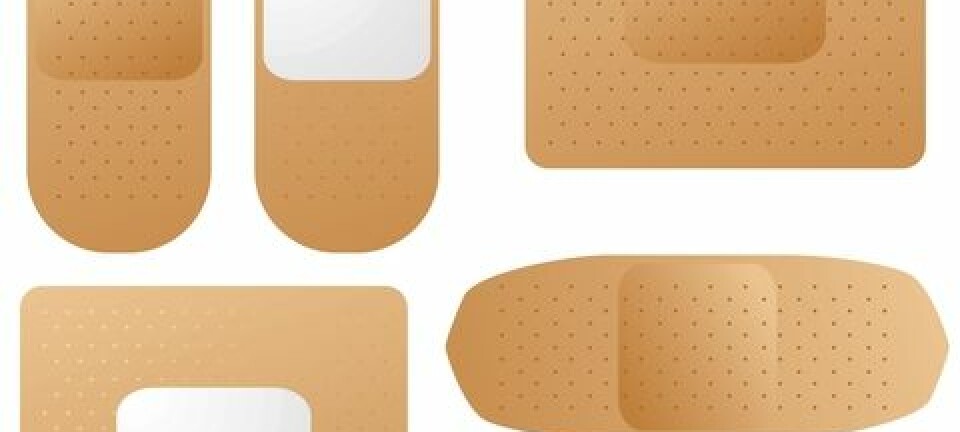
Insurance firm ponders nanoparticle risks
International experts on nanoparticles were recently invited to a symposium by the insurance company If. The firm wants to know whether nanoparticles could lead to some unpleasant surprises in the future
Denne artikkelen er over ti år gammel og kan inneholde utdatert informasjon.
Nanoparticles already have a lot going for them, and they can be even more useful in the future. They are expected to revolutionise solar cell technology and water purification, for instance, and hopefully they will be part of effective weapons against cancer and other diseases.
Nanomaterials are becoming ubiquitous. They make house paints more weather resistant, line our refrigerators to hamper bacterial and fungal growth, make tennis rackets and golf clubs lighter, help keep our shoes and clothes from becoming rank and make white sunscreen products rub clear on our skin.
Some 300,000 different nanomaterials have been invented in labs. Most of them have remained there, but thousands of retail products now contain nanoparticles. Many consumers are in daily contact with them, and some people encounter these microscopic molecules in their working environment.
How are we affected by such a barrage of nanoparticles?

The answer, according to the world’s leading experts, is that we simply don’t know. Some of them were recently invited to a workshop on the issue by the insurance company If, headquartered in Stockholm. If P&C Insurance has a monetary interest in calculating risk factors of future health problems among its clients.
Research on the health impacts of these materials is not abreast of developments. Despite a lack of health assessments, there are currently few restrictions on the use of nanomaterials in things we bring into our homes or use at the workplace.
No short-term damage
Still, there’s no reason to paint the situation black ― not yet, and hopefully never.
“A lot of solid data has been amassed about the effects of short-term exposure, and the materials don’t appear to be harmful on this time scale,” says Wolfgang Kreyling of Helmholtz Zentrum München. He was one of the 14 experts, including three Norwegians, who participated in the If discussions.

No documentation to date has ascertained health damage to humans who have been in contact with nanomaterials.
But there are still plenty of unknowns. As products using nanoparticles are so new, we know little about the impact of long-term exposure. Kreyling points out that we thus have no clear guidelines regarding how restrictive we should be in the use of nanomaterials.
Animal testing has indicated that nanoparticles can do harm if inhaled. This applies, for example, to certain types of carbon nanotubes.
Scientists have found these to damage lungs and other organs in test animals, according to a publication by the Norwegian Labour Inspection Authority.

But the picture is intricate. Nanomaterials comprise an enormous variety of substances, with a vast amount of qualities. Nobody can declare nanomaterials generally safe or unsafe.
But we do have experiences with other natural and manmade tiny particles, for instance from forest fires and volcanic eruptions ― or diesel engines. These can give some indications regarding certain types of nanoparticles, but these cannot be generalised.
Limited research on safety
“The health risks of these materials should be evaluated individually,” says James Bonner of North Carolina State University.
But that’s easier said than done, points out David C. Christiani of Harvard University.
“First we have to develop instruments for gauging the quantities of nanoparticles people are being exposed to in their homes and at their jobs. We don’t as yet have good techniques for registering nanoparticles in the human body.”
Ideally, safety considerations should be researched in parallel with development of the materials. Work would only be continued on ones that are designated safe,” says Roland Grafstrøm of Sweden’s Karolinska Institutet.
But such research lags behind. In the USA only four to five percent of the funding for nanomaterial research is relegated to studies of safety, according to Christiani.
Little regulation
Bonner says the US has few statutes regulating the use of nanomaterials at the workplace or in consumer goods. Nor do products containing nanoparticles have to be labelled with content information on them.
That is pretty close to the situation in Norway too, according to Olav Breen, an MD who works for If on future risk assessments.
“We have no restrictions regarding use of nanomaterials in products. But as of July this year all cosmetics that include nanoparticles must be labelled, he says.
Companies that use chemicals mandating mention in a product register must also declare any such substances in nanomolecular form. The Norwegian Product Register is an official list of toxic and dangerous chemicals.
However, Breen isn’t worried on the behalf of consumers who increasingly encounter nanoparticles in things they buy.
“It’s important that we research that too, but right now the most uncertainty is linked to workplaces where employees work with nanomaterials and risk inhaling them,” he says.
This is actually the background for If’s interest in the subject. They and other insurance companies sell work-related health and life insurance to employees. Pricing premiums in connection with various work situations entails assessments of health risks.
The potential health risk linked to nanomaterials is currently an unknown factor in the equation. Could nanoparticles, like careless use of asbestos in the past, prove to be a big health hazard some day and trigger huge pay-outs?
The insurance business has listed nanomaterials as one of four major focus areas linked to health risks. The others are electromagnetic fields, climate change and “fracking” for shale gas.
As of now there are no special restrictions on the use of nanomaterials at the workplace in Norway.
Assessed as a chemical
Despite that lack, nanomaterial use is germane to stipulations in Norway’s Working Environment Act.
Astrid Lund Ramstad of Norway’s Directorate for Labour Inspection explains that nanomaterials fit into a category of rules regulating chemicals.
These require the marking of any substances or materials classified as health hazards. In case of prospective problems, employers are required to chart and evaluate risks and initiate countermeasures, thus limiting employee exposure to a minimum.
“But it’s challenging for employers to acquire information about possible health effects. No health damage to humans has been reported to date. Many years could pass before we see any potential cases of disease,” says Lund Ramstad.
She thinks regulations of nanomaterials in statutes that were initially made to control the use of chemicals poses another challenge. These materials have unique qualities and as they have so little volume and weight they could sneak beneath the radar of regulations designed to limit the production and import of harmful chemical compounds.
“So at any given time, as we accumulate knowledge updates, we should evaluate whether specific laws should regulate nanomaterials. The Directorate for Labour Inspection has also published a handbook with information on rules for nanomaterials.”
“We need to issue information about possible risks to anyone who works with potentially harmful materials, enabling them to take precautions and minimise exposure,” she says.
All new technologies entail certain risks. Gregory Wagner of the US National Institute for Occupational Safety and Health says it’s most likely that prospective impacts of nanomaterials will take a long time to arise.
No fear of nanoproducts
“Caution is required. Nanotechnology can be dangerous. In conjunction with today’s uncertainties we have to protect employees while we obtain more knowledge,” says Wagner.
Bonner agrees: “When students work with carbon nanotubes in my laboratory, I want them to protect themselves and treat the substance as if it were the most dangerous type of asbestos, although this is probably not necessary.”
Otherwise, the experts are generally positive about nanotechnology. Bonner thinks the new materials represent more advantages than disadvantages. He has a more positive attitude regarding the materials today than he did when he first started looking into the safety aspects of nanomaterials.
The researchers are not particularly worried about using nanomaterials themselves. As Kreyling explains:
“If I were to choose, I’d buy a sunscreen containing nanoparticles because it works better. I think the risk of solar exposure is far greater than the possible risk of nanoparticles on our skin.”
------------------------
Read the Norwegian version of this article at forskning.no
Translated by: Glenn Ostling




































